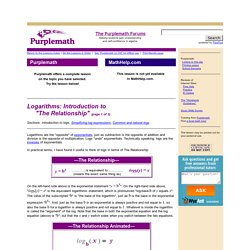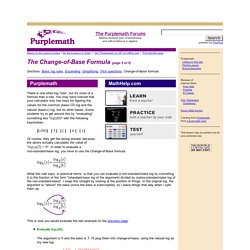

Logarithmic and exponential functions - Topics in precalculus. Exponential functions Inverse relations Exponential and logarithmic equations Creating one logarithm from a sum THE LOGARITHMIC FUNCTION WITH BASE b is the function y = logb x. b is normally a number greater than 1 (although it need only be greater than 0 and not equal to 1).

Note the following: • For any base, the x-intercept is 1. To see the answer, pass your mouse over the colored area. The logarithm of 1 is 0. y = logb1 = 0. Logarithms: Introduction to "The Relationship". Purplemath offers a complete lessonon the topic you have selected.Try the lesson below!

This lesson is not yet availablein MathHelp.com. Logarithms: Introduction to "The Relationship" (page 1 of 3) Sections: Introduction to logs, Simplifying log expressions, Common and natural logs Logarithms are the "opposite" of exponentials, just as subtraction is the opposite of addition and division is the opposite of multiplication. Logs "undo" exponentials. In practical terms, I have found it useful to think of logs in terms of The Relationship:
Working with Exponents and Logarithms. What is an Exponent?

What is a Logarithm? A Logarithm goes the other way. It asks the question "what exponent produced this? ": And answers it like this: In that example: The Exponent takes 2 and 3 and gives 8 (2, used 3 times in a multiplication, makes 8) The Logarithm takes 2 and 8 and gives 3 (2 makes 8 when used 3 times in a multiplication) A Logarithm says how many of one number to multiply to get another number So a logarithm actually gives you the exponent as its answer: (Also see how Exponents, Roots and Logarithms are related.) Working Together Exponents and Logarithms work well together because they "undo" each other (so long as the base "a" is the same): They are "Inverse Functions" Doing one, then the other, gets you back to where you started: Doing ax then loga gives you x back again: Doing loga then ax gives you x back again:
CHANGING THE BASE OF A LOGARITHM. Let a, b, and x be positive real numbers such that and (remember x must be greater than 0).

Then can be converted to the base b by the formula Let's verify this with a few examples. Example 1: Find to an accuracy of six decimals. . , and 7 is between 3 and 9. Can be written. Basic Log Rules / Expanding Log Expressions. Basic Log Rules / Expanding Logarithmic Expressions (page 1 of 5) Sections: Basic log rules, Expanding, Simplifying, Trick questions, Change-of-Base formula You have learned various rules for manipulating and simplifying expressions with exponents, such as the rule that says that x3 × x5 equals x8 because you can add the exponents.

There are similar rules for logarithms. The Change-of-Base Formula. The Change-of-Base Formula (page 5 of 5) Sections: Basic log rules, Expanding, Simplifying, Trick questions, Change-of-Base formula There is one other log "rule", but it's more of a formula than a rule.

You may have noticed that your calculator only has keys for figuring the values for the common (base-10) log and the natural (base-e) log, but no other bases. Some students try to get around this by "evaluating" something like "log3(6)" with the following keystrokes: Of course, they get the wrong answer, because the above actually calculates the value of "log10(3) × 6". What this rule says, in practical terms, is that you can evaluate a non-standard-base log by converting it to the fraction of the form "(standard-base log of the argument) divided by (same-standard-base log of the non-standard-base)". This is how you would evaluate the last example on the previous page: Evaluate log3(6). The argument is 6 and the base is 3. Then the answer, rounded to three decimal places, is: log3(6) = 1.631. Logarithms rules and formula. Product rule, power rule, quotient rule and other formulas for logarithms.